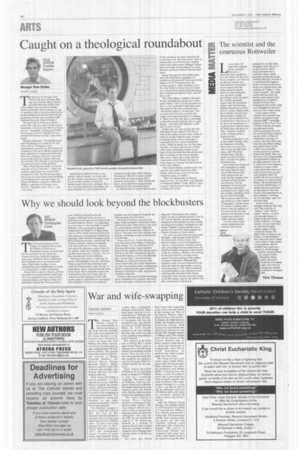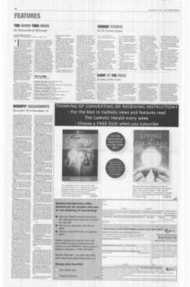Page 14, 8th December 2006
Page 14

Report an error
Noticed an error on this page?If you've noticed an error in this article please click here to report it.
Tags
Share
Related articles
Eden Is Not Usually Quite So Seductive
We're All Surrealists Now
Long Lost Madonna And Child Rediscovered
Ladies Take To The Gallery
Change And Controversy On Show In 1991
Why we should look beyond the blockbusters
Christopher
Lloyd
The Courtauld Institute of Art Gallery at Somerset House and the Wallace Collection in Manchester Square are both wellknown and much-loved venues for London art lovers. Both also organise temporary exhibitions that complement their holdings and so encourage return visits. Often when London is overwhelmed by major blockbusters it is easy to overlook these smaller exhibitions.
David Teniers and the Theatre of Painting at the Courtauld Institute (until January 21) is inspired by one of the earliest and most famous art history books ever published, namely the Theatrum Picto rium (1660) by David Teniers the Younger. Although better known as a landscape and peasant genre painter in the Flemish tradition, Tethers was appointed as court painter to the Archduke Leopold Wilhelm, who governed the Spanish Netherlands for Philip IV of Spain from 1647 to 1656. While in Brussels the archduke formed an outstanding collection of paintings with wonderful examples of the Italian High Renaissance (particularly the Venetian school), which he eventually took back with him to Vienna. Teniers specialised in depicting general views of the gallery, where the archduke is shown proudly inspecting his collection. Two of these pictures are in the exhibition.
Theatruni Pictoriwn is a selection of nearly 250 highlights from the collection. Teniers supervised the publication and made the small painted copies for the 14 printmakers whose work formed the basis of the book. These delightful copies had in themselves become sought after by collectors at the beginning of the 18th century and it is these that have prompted this exhibition. 26 have been gathered together and are displayed alongside the relevant prints from the book.
Theatrum Pictorium was not a catalogue of the archduke's collection, which numbered nearly 4,000 pictures, but more of a presentation volume evoking the experience of viewing the collection in person. The book ran to five editions and remains a defining moment in the history of collecting.
Pomp and Power: French Drawings from Versailles at the Wallace Collection (until January 7) is an exhibition of 52 drawings illustrating French national history in the context of the famous palace built by Louis XIV. Abandoned after the French Revolution, it was Louis-Philippe (the "citizen king") who restored the buildings as a museum not just of the ancien regime but also of the Napoleonic era and even commissioned contemporary artists to make good the gaps created by missing or destroyed works. Acquisitions continue to this day.
Variety is the essence of this fascinating show, extending from portraits and architectural drawings to historical scenes and allegories. Pertaining to the original palace are the remarkable general view by A F van der Meulen, the two charming miniatures of the gardens by Jean Cotelle, the allegorical subjects undertaken by the tireless Charles Le Brun and the clever portrait of Louis XVI when dauphin by Charles Germain de Saint-Aubin.
It is, however, the historical scenes that dominate, with Jacques-Louis David's The Oath of the Tennis Court, JeanBaptiste Isabey's record of Napoleon's visit to a velvet factory at Rouen and the truly astonishing bravura performance by Jean-Demosthene Dugourc of the funeral of the duc de Berry. Of these, the drawing by the great David is of major consequence since his painting of the subject remained unfinished. Although this dramatic scene was not witnessed by the artist, he made his memorable compositional drawing in 1791 while he himself was participating in the turbulent events following the downfall of the French monarchy. It has become an iconic image of the Revolution, and no one should miss this confrontation with history.
blog comments powered by Disqus



















